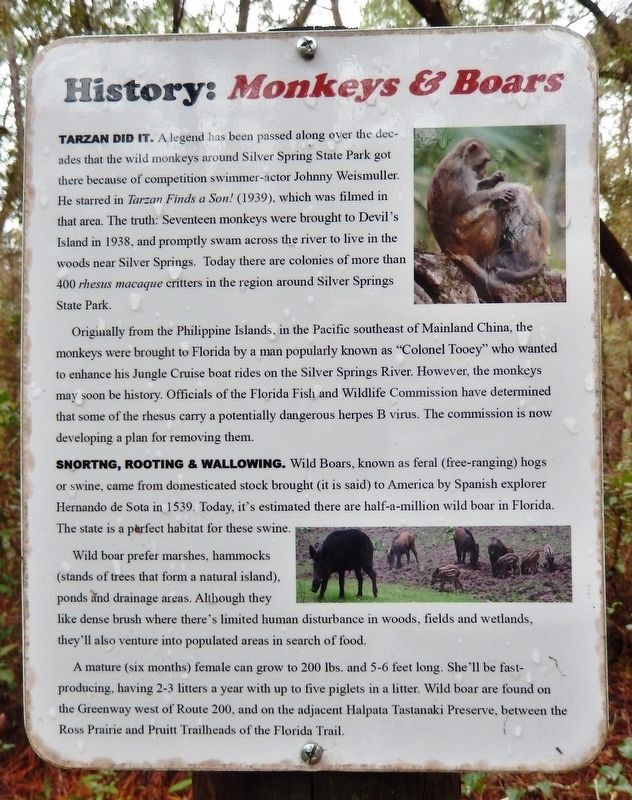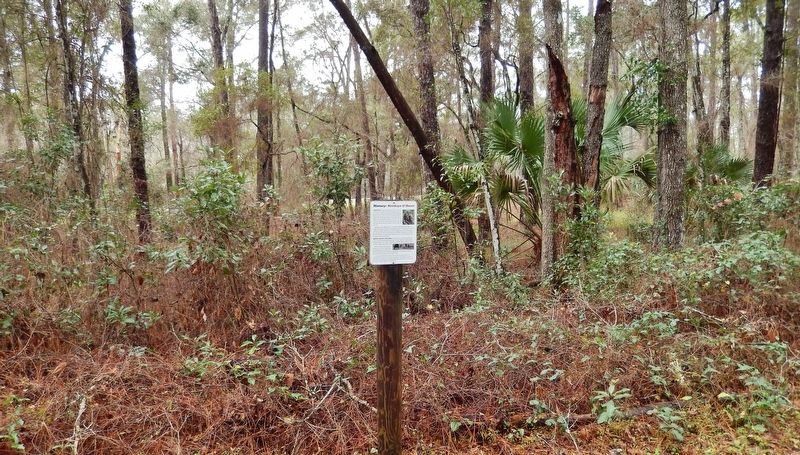Near Ocala in Marion County, Florida — The American South (South Atlantic)
History: Monkeys & Boars
Historic Florida Barge Canal Trail
Originally from the Philippine Islands, in the Pacific southeast of Mainland China, the monkeys were brought to Florida by a man popularly known as "Colonel Tooey" who wanted to enhance his Jungle Cruise boat rides on the Silver Springs River. However, the monkeys may soon be history. Officials of the Florida Fish and Wildlife Commission have determined that some of the rhesus carry a potentially dangerous herpes B virus. The commission is now developing a plan for removing them.
Snorting, Rooting & Wallowing. Wild Boars, known as feral (free-ranging) hogs or swine, came from domesticated stock brought (it is said) to America by Spanish explorer Hernando de Sota in 1539. Today, it's estimated there are half-a-million wild boar in Florida. The state is a perfect habitat for these swine.
Wild boar prefer marshes, hammocks (stands of trees that form a natural island), ponds and drainage areas. Although they like dense brush where there's limited human disturbance in woods, fields and wetlands, they'll also venture into populated areas in search of food.
A mature (six months) female can grow to 200 lbs. and 5-6 feet long. She'll be fast-producing, having 2-3 litters a year with up to five piglets in a litter. Wild boar are found on the Greenway west of Route 200, and on the adjacent Halpata Tastanaki Preserve, between the Ross Prairie and Pruitt Trailheads of the Florida Trail.
Erected by Florida State Parks.
Topics. This historical marker is listed in these topic lists: Animals • Exploration • Parks & Recreational Areas. A significant historical year for this entry is 1938.
Location. 29° 6.053′ N, 82° 5.305′ W. Marker is near Ocala, Florida, in Marion County. Marker can be reached from the intersection of Southeast 80th Street (County Road 328) and South Pine Avenue (U.S. 441), on the right when traveling east. Marker is located along the trail at "The Island" - Cross Florida Barge Canal Interpretive Park, just south of the Marion County Sheriff's Station. Touch for map. Marker is at or near this postal address: 3260 Southeast 80th Street, Ocala FL 34480, United States of America. Touch for directions.
Other nearby markers. At least 8 other markers are within walking distance of this marker. History: Cows & Horses (here, next to this marker); Green Monsters (within shouting distance of this marker); History: Crops (about 300 feet away, measured in a direct line); Greenway Greenlife (about 300 feet away); Cat Face (about 300 feet away); Florida Crackers (about 500 feet away); Florida Seminoles (about 500 feet away); A Tribe Lost: Timicua (about 500 feet away). Touch for a list and map of all markers in Ocala.
Related markers. Click here for a list of markers that are related to this marker. Historic Florida Barge Canal Trail
Also see . . .
1. These wild monkeys thrive in Florida—and carry a deadly virus. In the heart of central Florida lies Silver Spring State Park—a large patchwork of forests and wetlands with a spring-fed river flowing through it. One of Florida’s first tourist attractions, the park was once known for its scenic vistas and native wildlife. But for the last 80 years, the park’s biggest draw has been its monkeys. (Submitted on February 26, 2021, by Cosmos Mariner of Cape Canaveral, Florida.)
2. Herpes-carrying monkeys brought to Florida for tourism may multiply out of control. From 1984 to 2012, about 1,000 monkeys were removed or sterilized through permits issued by the state. But since 2012, the Department of Environmental Protection stopped issuing removal permits when it became known that trapped monkeys wound up at research facilities. Since then, the monkeys have continued to reproduce unchecked. The only state action came from the Florida Fish and Wildlife Conservation Commission, which in 2018 prohibited the feeding of wild monkeys. (Submitted on February 26, 2021, by Cosmos Mariner of Cape Canaveral, Florida.)
3. Hernando de Soto 1539–1540 Winter Encampment at Anhaica Apalachee. From October 1539 through March 1540, the Spanish conquistador Hernando de Soto and his expedition of more than 600 people occupied the Apalachee capital of Anhaica, located in present-day Tallahassee. Soto brought a wide array of people including soldiers, slaves, craftspeople, and bureaucrats. He also brought along a herd of swine that he intended to use for food at a planned colony. (Submitted on February 26, 2021, by Cosmos Mariner of Cape Canaveral, Florida.)
Additional keywords. History: Monkeys & Boars
Credits. This page was last revised on February 26, 2021. It was originally submitted on February 20, 2021, by Cosmos Mariner of Cape Canaveral, Florida. This page has been viewed 295 times since then and 53 times this year. Photos: 1, 2. submitted on February 26, 2021, by Cosmos Mariner of Cape Canaveral, Florida.

